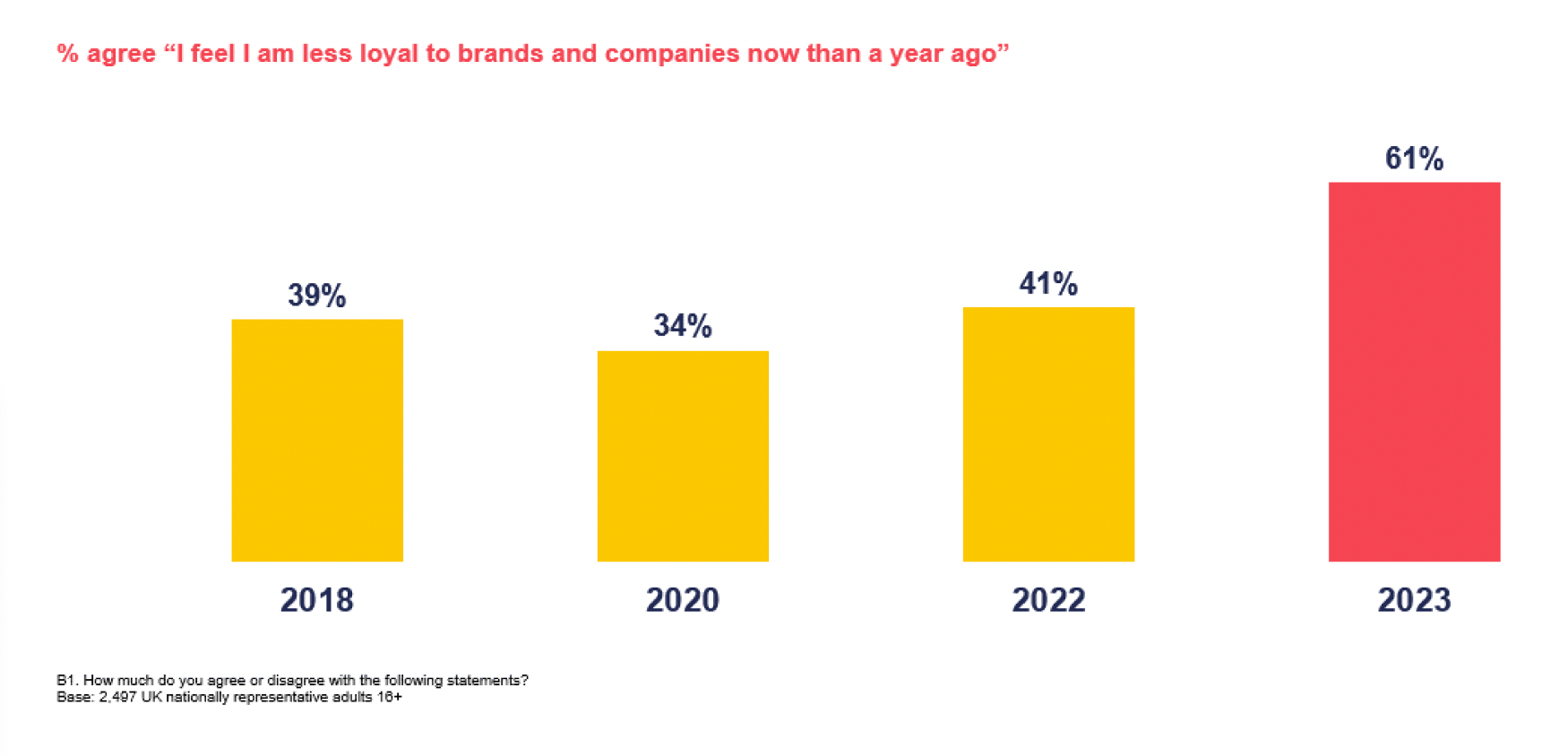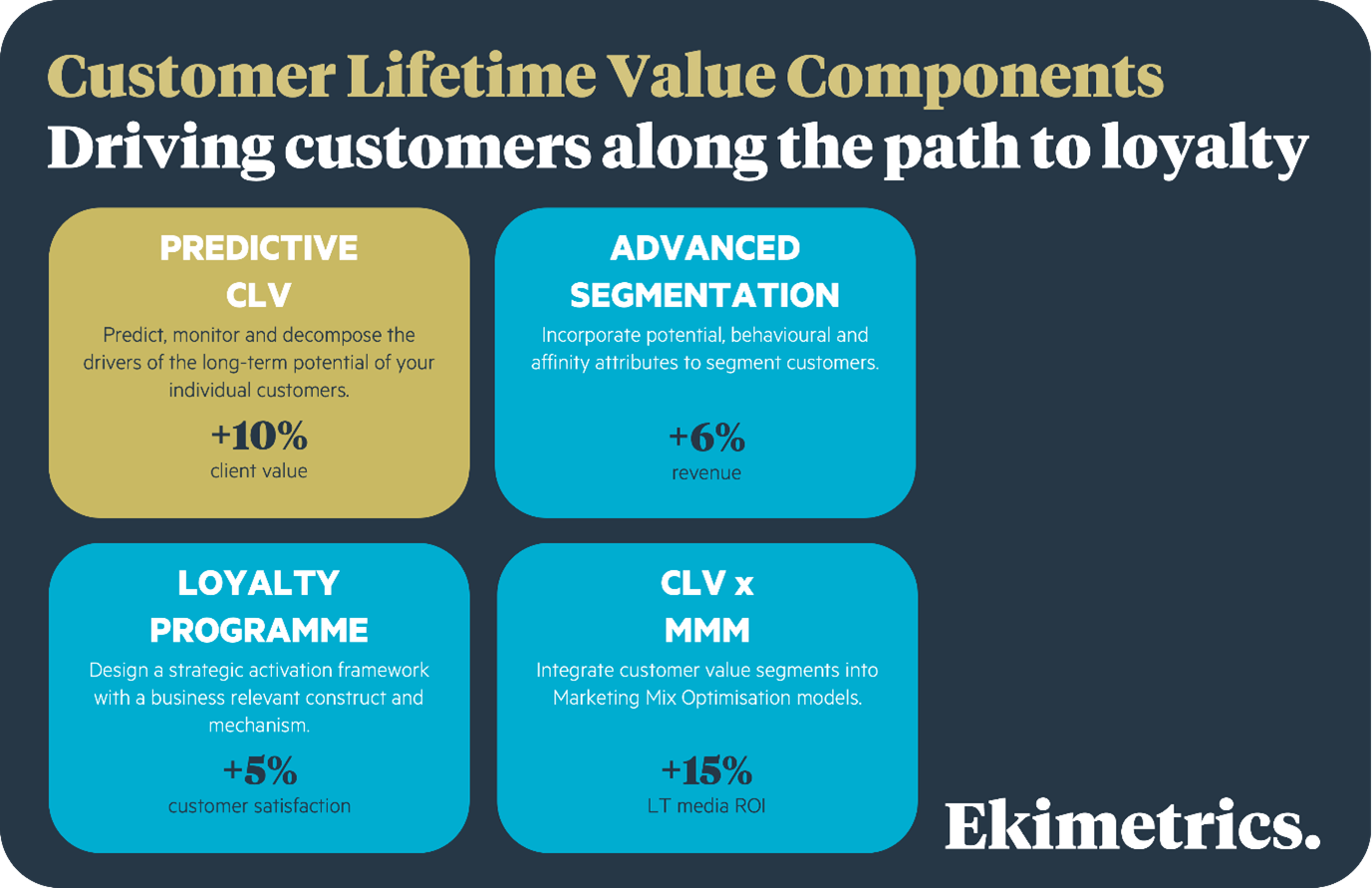Driving Customer Loyalty: Why mass market brands still need to focus on CLV as a core metric
Back to all articles
Driving Customer Loyalty: Why mass market brands still need to focus on CLV as a core metric
As customers are more informed, more spontaneous, more tuned in to one another’s opinions and have less in their pocket, they are often also less brand loyal.

Yet we all know that customer loyalty is a critical component of long-term business success.
Why loyalty still matters (and pays off)
Despite the challenges, loyalty remains a golden lever of profitability:
• Higher Customer Lifetime Value (CLV): Loyal customers spend more, stay longer, and require less convincing.
• Lower Acquisition Costs: Keeping customers is cheaper than constantly replacing them.
• Resilience to Competition: A loyal customer is less price-sensitive and less likely to defect to a competitor.
What’s more, loyal customers act as brand advocates, helping businesses tap into powerful word-of-mouth and social sharing, amplifying their brand organically.
Against this backdrop, it’s imperative that brands have a complete understanding of their customers; to acquire them, grow them, and continuously improve the businesses through long-term growth and profitability.
As far back as 2014, Harvard Business Review revealed that customers who had the best past experiences spend 140% more than those who had the poorest past experiences.
“Searching for the gains in driving loyalty is a critical part of doing business.”
Which is where customer analytics comes in. In many industries, especially those rich with customer data, customer analytics has a well-established role and is often regarded as the gold standard of the value data science can bring. Searching for the gains in driving loyalty is a critical part of doing business.
Role of Customer Analytics in Mass Markets
Mass markets present unique challenges and opportunities for businesses. Some industries, such as financial services, are awash with customer behaviour data. Others, such as CPGs, remain largely one-step removed from the customer, where distributors hold the cards. And while supermarket loyalty schemes are nothing new, we’ve seen in recent years new tactics placing direct value on data, such as through loyalty scheme member pricing, rewards and personalised offers.
Nonetheless, even where customer behaviour information and purchase patterns are highly disparate, customer analytics is still one of the most powerful enablers companies have for translating data into useful insights about their customers.
That’s because customer data is no longer solely captured in sales or customer management platforms. Aggregated sources such as from social media, feedback surveys, and reviews are great ways to supplement or become proxies for data from e-commerce platforms and customer service interactions.
"Businesses can determine the most effective and profitable strategies”
The volumes available to mass market brands make it possible to deliver highly accurate models to help companies navigate the drivers of loyalty with easy to understand and actionable insights into customer preferences, behaviours, and trends. And with this comprehensive understanding of their customers, businesses can determine the most effective and profitable strategies, reducing acquisition and costs, enhancing the reputation and providing long-term growth.
Putting the customer at the heart of decision-making
Customer-centricity is no longer a buzzword – it’s a strategic necessity. However, it can often become focused on micro-management of communications, rather than a holistic approach to the customer and CLV.
Businesses that genuinely put the customer at the centre of every decision see tangible benefits:
• Enhanced Experience: Better alignment with customer needs leads to smoother journeys and better satisfaction.
• Greater Retention: Satisfied customers are more likely to stay loyal to a brand. Retaining existing customers is often more cost-effective than acquiring new ones.
• Stronger Brand Equity: A reputation for being truly customer-first builds trust and competitive edge.
From product design to loyalty programmes to pricing models, businesses must align decisions with what customers truly value. Indeed, a 2024 Emarsys report found that poor customer experience, quality and price rises were the biggest contributors to customer churn.
The financial imperative of driving customer lifetime value
Understanding long-term growth potential, and showing the value and impact of customer analytics helps answer one of the most common questions: "How will this impact the top line growth?"
“Standardised metrics become the common measurement currency and help bridge the language between CMO and CFO”
With the right analytics, loyalty can be directly linked to profitability. From modelling customer lifetime value (CLV) to forecasting future revenue from retention improvements. To tie measurement to the strategic outlook of a business and view customer satisfaction & loyalty as a key enabler to realise the company’s broader vision, standardised metrics become the common measurement currency and help bridge the language between CMO and CFO, ensuring the accountability and objectives of each are aligned. Which is especially important when CFOs are concerned with publicly reporting financial results quarterly and CLV is fundamentally a long-term measure of business health.
That’s why, at Ekimetrics, we quantify tangible ROI gains through customer-centric and marketing strategies to be expressed in financial terms. These can be easily integrated within the companies’ financial reports with CLV solutions deployed in under three months.
The value of building a customer analytics programme in mass markets
There is rarely a single route to developing customer analytics maturity, though today more than ever, it can be fast, expansive and integrated not just with an existing tech stack for communications activations, but with other measurement methodologies too. Giving a real 360 of the customer to optimise activation and drive the impact not just of direct action on CLV, but the whole marketing ecosystem.
At Ekimetrics, we use well-defined AI solutions to drive customers along the path to loyalty, from predictive CLV to integrating customer value segments into marketing with CLV x Marketing Mix Optimisation models.

Predictive CLV allows you to predict, monitor and decompose the drivers of the long-term potential of your individual customers. The benefit of predictive CLV is that it unites business functions to a north star KPI that drives long-term business health, with a forward-looking view of performance. Typically, we find that deploying Predicitve CLV increases value by around 10%.
Underpinning the core analytics of predictive CLV is advanced segmentation, which segments customers by their potential, behavioural and affinity attributes. This allows you to unlock the customer journey and deliver enriched activation and personalisation at scale. Typically, this delivers around 6% more revenue.
You can also enhance the understanding delivered by CLV to design and measure the tangible benefits of loyalty programmes, ensuring the construct and mechanism is relevant to the business and with the knowledge to continuously optimise towards incremental uplift. Here we’ve seen customer satisfaction scores increase by 5% and profit growth up to 10%
Finally, and perhaps the most ground-breaking use of CLV in modern marketing analytics, is the integration of CLV into Marketing Mix Modelling (MMM) or Marketing Mix Optimisation (MMO). By using customer value segments in MMM, you can take strategic budget decisions with the acquisition of higher-value customers as a key objective. Which means optimising to a long-term and customer-centric ROI. Here, we would expect to see in the region of a 15% increase in lifetime media ROI.
Mass market customer analytics in action
Retail: The Battle for Relevance
In the retail sector – especially in fashion, grocery, and lifestyle – customers are inundated with choices and discounts. Which as we saw from the DMA study is resulting in brand loyalty erosion.
Key challenges
• Difficulty differentiating in a commoditised product landscape.
• Low visibility into why customers abandon carts, switch brands, or only buy during sales.
• Fragmented view of omnichannel shoppers.
How analytics helps
• Customer segmentation helps identify high-frequency, high-value shoppers – or those with the potential to become high-value - versus discount-only buyers.
• Path-to-purchase analysis uncovers friction points across digital and in-store touchpoints.
• Personalisation engines deliver targeted product recommendations and promotions in highly competitive, direct-to-consumer environments.
• Predictive models highlight at-risk customers before they churn.
Value delivered
Our global beauty leader client gained:
• +30% Efficiency in loyalty programme activation through predictive CLV
• +14% Targeting uplift
• 22M+ Customer lifetime values predicted
Automotive: Informing strategies in complex data environments
In a competitive environment where customers have multiple options for vehicles, services and ownership models, especially with the industry-transformation as we switch to EVs, it is crucial to understand and maximise the monetary value generated by individual customers over time. Not only does this enable effective marketing targeting and offer customisation, the increasing availability of connected car data and different servicing requirements can profoundly impact in-life actions too. All of which matters to long-term profitability maximisation.
Challenges
• Integrating data from different sources (e.g., sales, marketing, customer service and connected car behaviour data) to calculate lifetime value can be complex
• Moving from general to individual lifetime value estimation requires precise data analysis and modeling
• Establishing a connection between historical behaviour and future potential value demands sophisticated predictive modelling
Our approach
• Segment customers based on a comprehensive set of characteristics
• CLV Calculation: Use statistical and machine learning models to accurately calculate the lifetime value of each customer segment
• Predictive Modelling to forecast future customer behaviour and lifetime value, incorporating factors such as customer churn, repeat purchases, and market trends
Value delivered
Revisiting strategy & activations based on CLV for an Automotive industry leader resulted in:
• 10% ROI from year 1 of implementation
• A CRM strategy based on customers' long-term profiles
Banking/Insurance: Getting deeper in a matured customer and analytics market
Financial Services is arguably the most mature market when it comes to using customer analytics. Across banking, lending, payment, investments and insurance, all financial services brands have been the driver of the discipline, which brings some unique challenges.
Challenges
• Navigate complex industry regulations and security constraints
• Gather and unify data from marketing, sales, commercials, investments, savings etc. for a 360 view
• Develop increasingly sophisticated customer segments that tie customers' behaviours with their transactions and engagement that is relevant for all business teams
• Build predictive & targeting recommendations together with industry experts
• Drive further sophistication and gains in an already data savvy sector
Our Approach
• Discovery interviews to align on key challenges across business verticals and hypothesise potential solutions
• Algorithm development using ML tools and a responsible AI approach
• Supporting the business teams to ensure adoption of the solution
Value Delivered
For a large French bank that offers both banking and insurance, cluster movement analysis with unified identification across divisions to ease targeting and optimisation:
• +4M customers covered to identify ‘high-potential’ customers
• +3% annual revenue on one segment by upgrading one of the 8 segments through cross-sell
• +0.5% of estimated annual cashflow increase on one segment, by re-engaging inactive customers through the activation of recurrent monthly payments
Summary
Each industry faces unique loyalty and customer analytics challenges depending on its maturity. That’s why a one-size-fits-all approach doesn’t work. To drive measurable growth through a customer-focused strategy, it’s essential to first understand the business challenges. Successful use of loyalty programmes and Customer Lifetime Value (CLV) depends on this, as it guides how customer analytics can deliver real impact.
To find out more about how our solutions are ready to deploy and seamlessly integrate within existing tech stack and activation platforms, without the need for lengthy and expensive CRM implementation programmes, get in touch. We’d love to hear from you.
Useful resources:
Whitepaper: The Role of Customer Analytics Throughout the Value Chain
Whitepaper: Driving long term performance with customer lifetime value
Our solutions: Customer Analytics

